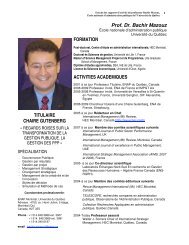Why do firms both make and buy? An investigation of concurrent ...
Why do firms both make and buy? An investigation of concurrent ...
Why do firms both make and buy? An investigation of concurrent ...
Create successful ePaper yourself
Turn your PDF publications into a flip-book with our unique Google optimized e-Paper software.
294 A. Parmigiani<br />
Table 1. Summary <strong>of</strong> predictions <strong>and</strong> results<br />
Hypothesis <strong>and</strong> variable Prediction (if high) Logic Models Results a<br />
H1 tce Asset specificity Produce greater %<br />
internally<br />
H2tce Volume uncertainty Produce greater %<br />
internally<br />
H3tce Performance Produce greater %<br />
uncertainty<br />
internally<br />
H2 neo Volume uncertainty Concurrently<br />
source<br />
H3 neo Performance<br />
uncertainty<br />
H4 neo Firm <strong>and</strong> supplier<br />
scope economies<br />
H5 cap Firm & supplier<br />
expertise<br />
H6 cap Technological<br />
uncertainty<br />
a CS, <strong>concurrent</strong>ly source.<br />
Concurrently<br />
source<br />
Concurrently<br />
source<br />
Concurrently<br />
Source<br />
Concurrently<br />
Source<br />
hypotheses suggest a continuum, while others propose<br />
a discrete choice, with <strong>concurrent</strong> sourcing<br />
not necessarily in between making <strong>and</strong> <strong>buy</strong>ing.<br />
Table 1 summarizes the predictions <strong>and</strong> previews<br />
the results. The following empirical study along<br />
with ordinal <strong>and</strong> discrete modeling techniques<br />
assist in providing evidence <strong>both</strong> about when <strong>firms</strong><br />
would <strong>concurrent</strong>ly source <strong>and</strong> about the nature <strong>of</strong><br />
this decision.<br />
RESEARCH DESIGN<br />
The context for this study involves the sourcing<br />
decisions <strong>of</strong> metal stamping <strong>and</strong> powder metal<br />
Make to protect against<br />
supplier opportunism<br />
1, 2, 3, 4 Not supported<br />
Models 5, 6 support<br />
Make > Buy <strong>and</strong><br />
CS > Buy<br />
1, 2, 3, 4 Not supported<br />
Make to better able to<br />
coordinate <strong>and</strong> adapt<br />
Make to align incentives<br />
by using authority<br />
1, 2, 3, 4 Supported<br />
Models 5, 6 support<br />
Make > Buy <strong>and</strong><br />
Make > CS<br />
Make to fully utilize<br />
capacity<br />
Buy to gain flexibility<br />
5, 6 Not supported<br />
Make to better specify <strong>and</strong><br />
evaluate<br />
Buy to benchmark<br />
5, 6 Not supported<br />
Make to enjoy lower costs 5, 6 Supported<br />
Buy to gain lower prices Firm: Make > CS ><br />
Buy<br />
Supplier: Make < CS<br />
< Buy<br />
Combined: Make ><br />
Buy <strong>and</strong> CS > Buy<br />
Make to leverage<br />
5, 6 Supported<br />
competencies<br />
Buy to learn from<br />
suppliers<br />
Firm: Make > CS ><br />
Buy<br />
Combined: Make <<br />
Buy <strong>and</strong> CS ><br />
Make<br />
5, 6 Supported<br />
Make to underst<strong>and</strong> <strong>and</strong><br />
interpret<br />
Buy to gain diverse views CS > Make<br />
<strong>firms</strong> for production tooling <strong>and</strong> services. These<br />
two sectors <strong>of</strong> the metal forming industry consist<br />
<strong>of</strong> numerous, independent, mature, small <strong>firms</strong>.<br />
The attributes <strong>of</strong> these <strong>firms</strong> help to rule out<br />
alternative explanations for <strong>concurrent</strong> sourcing,<br />
such as inertia, corporate parent influence, or slack<br />
resources (Penrose, 1959). Both the <strong>firms</strong> <strong>and</strong><br />
their suppliers are relatively small, which assists<br />
in controlling for explanations <strong>of</strong> sourcing strategy<br />
based upon a power differential, such as a<br />
large, powerful <strong>buy</strong>er that can act without considering<br />
a supplier’s response, since it knows<br />
the supplier will comply (Porter, 1980). These<br />
<strong>firms</strong> rarely use <strong>buy</strong>er/supplier alliances or other<br />
more sophisticated mechanisms, simplifying the<br />
Copyright © 2007 John Wiley & Sons, Ltd. Strat. Mgmt. J., 28: 285–311 (2007)<br />
DOI: 10.1002/smj





